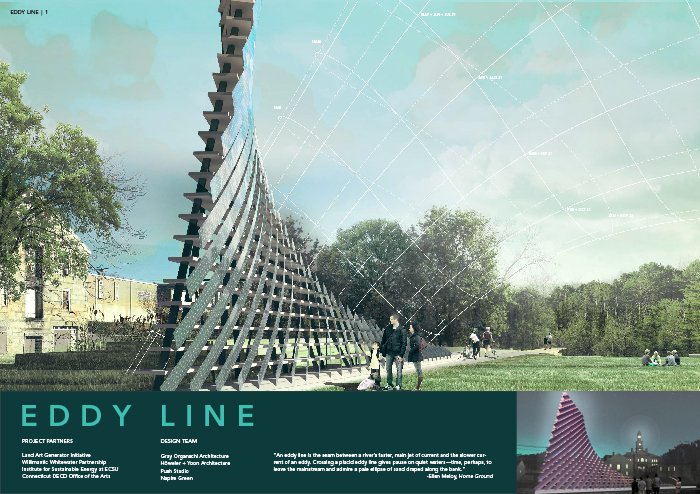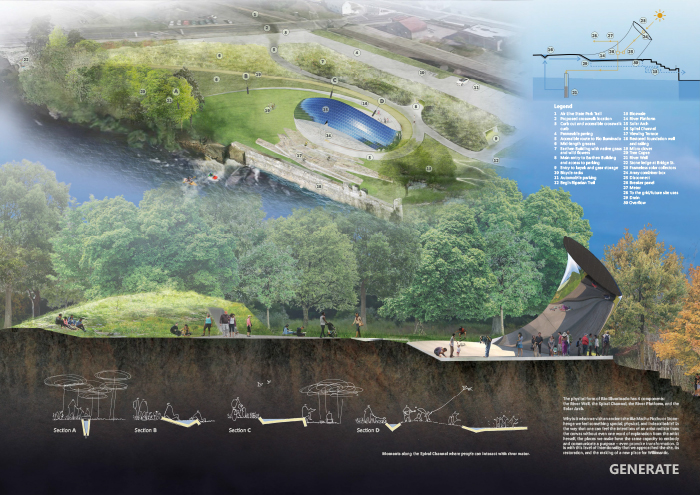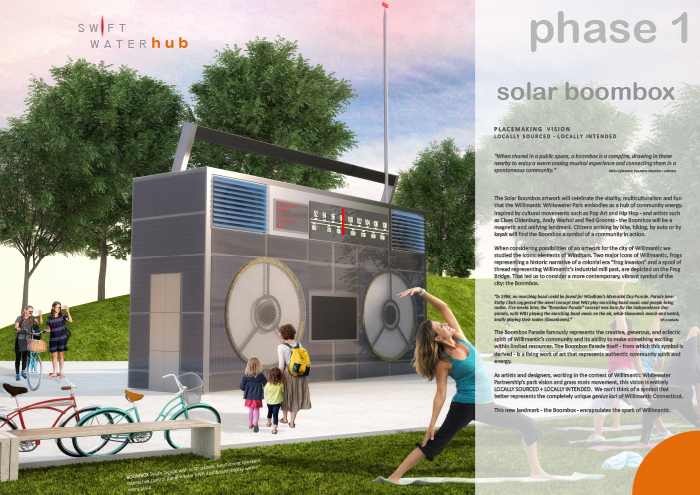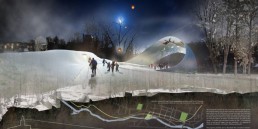A small town in Connecticut has created an inspiring new blueprint for post-industrial socioeconomic upliftment.
Part of Windham, and formerly nicknamed “Thread City”, Willimantic will soon announce the winner of the LAGI Willimantic design competition that will see the development of an energy-generating work of public art. The competition comprises part of a much larger initiative to revive the community, which in the mid 1980s lost its status as a major nerve center for textile-manufacturing.
The textile industry supported thousands of people over a period of 130 years, according to the National Park Service, deriving energy from the Willimantic River to power its mills. But then in 1985, the American Thread Company closed its plant and shifted operations to North Carolina, leaving in its wake a gaping economic hole.
 Eddy Line by Höweler+Yoon & Gray Organschi.
Eddy Line by Höweler+Yoon & Gray Organschi.
Like many post-industrial communities across the United States, Willimantic faced the enormous task of reinventing itself, but it would take time. In 2002, the Hartford Courant reported a disproportionate prevalence of heroin use. “The Willimantic River, which once powered the textile mills that made the city prosperous, now draws junkies to its muddy banks to shoot up,” the paper reported at the time. “Discarded needles and empty glassine heroin packets litter the river’s edge.” Concerned to reconnect the city with the neglected river, that same year the Willimantic Whitewater Partnership (WWP) set in motion a series of transformational community-centered projects with their purchase of a 3.4-acre site right off main street. James Turner, president of the nonprofit organization, said the empty lot “at the foot of town hall” had been “seriously contaminated for decades.”
 Rio Iluminado by Pirie Associates, Lindsay Suter, and Gar Waterman.
Rio Iluminado by Pirie Associates, Lindsay Suter, and Gar Waterman.
WWP’s vision for the site is threefold, according to Turner: They want to get national whitewater enthusiasts into the water (Turner says the site lies within a mile of a 100-foot drop that creates some exciting rapids); they want to create an urban green space for recreation with food trucks, farmers markets, music festivals and other community events; and finally, they want to create a hub where several long hiking trails converge. “If you’re a hiker or a cyclist coming into town,” Turner says, this would be the place to recharge your phones, use the restroom, or find out where to get a hamburger or beer.
To jumpstart their vision, WWP first had to cleanup their riverfront property. To do this, they applied for and in 2013 scored a $200,000 EPA grant to remediate the brownfield site, a task that included removing all remnants of a gas station that had replaced the former mills. Turner says the remediation process was completed in the last couple of years, and more recently, thanks in part to WWP’s efforts, work on a mile-long downtown river trail has also concluded.
In the meantime, Kristina Newman-Scott, Director of Culture in the Office of the Arts & Historic Preservation, with the State of Connecticut’s Department of Economic and Community Development (DECD), describes coming across the Land Art Generator Initiative at the American for the Arts conference when it was held in Pittsburgh. “I immediately knew that they were doing something incredibly unique,” she says, “and that Connecticut needed to know more about it.” Newman-Scott lamented that it wasn’t in the cards to work on a project with co-founders Elizabeth Monoian and Robert Ferry while she was still working for the City of Hartford. “But when I got the role as the head of arts and culture for the State of Connecticut,” she says, “they were on my priority list of partners.”
 Solar Boombox by Dinep+Schwab, Ted Efremoff, and Matt Macunas.
Solar Boombox by Dinep+Schwab, Ted Efremoff, and Matt Macunas.
Newman-Scott says she meets many project leaders interested to incorporate a sustainability component, but they often take a traditional approach. She thought it would be a perfect time to invite LAGI to work on a project at a small enough scale that would be feasible (funding is a factor) and that would enable the community to see change in real time, providing a model for the entire state. Newman-Scott and her team eventually connected Monoian and Ferry with WWP, which was already toying with ideas around creative placemaking for their downtown property, and a slew of other local stakeholders with various backgrounds. Newman-Scott says the process of linking the various partners was “so organic”. “It was like when you have all the right ingredients to make the best one-pot meal,” she laughs.
On March 3, 2017, the Institute for Sustainable Energy (ISE) at Eastern Connecticut State University (ECSU) and the DECD Office of the Arts hosted LAGI for a community workshop in Willimantic to discuss the WWP site’s various challenges and opportunities, culminating in the decision to launch LAGI Willimantic. The project needed to exhibit the WOW factor to draw in both local and outside visitors and expand its potential to catalyze economic and community development. Jessica LeClair, Energy Technical Specialist for ISE, says LAGI Willimantic merges placemaking with renewable energy use, building community connections at the same time. “We see the LAGI Willimantic project as a possible model that we could share with others across the state.”
In November, 2017, 15 teams submitted responses to a Request for Qualifications and three were selected to submit concept design proposals. After close consultations with the community through many outreach events, the three teams then presented their final designs to Willimantic on 14 April, 2018 in the lobby of ECSU’s Student Union. Roughly 50 people came out to vote for their preferred design, according to Turner, and the winner will be announced at CT Arts Day in Hartford on 25 April, 2018.
Turner says the democratic process that led to the realization of this project isn’t about any one person, but rather allows the community to decide how it sees itself. With LAGI, according to Newman-Scott, “you’re creating a sense of space, you’re a creating this physical space that makes people feel further connected, and then you’re putting energy back on the grid.”
Tafline Laylin is a freelance communicator and journalist who strives for global environmental and social justice. Her work has appeared in The Guardian, The Atlantic, OZY.com, and a variety of other international publications.
Related Posts
1 Comment
Add comment Cancel reply
This site uses Akismet to reduce spam. Learn how your comment data is processed.


[…] Rio Iluminado won the LAGI Willimantic design competition in Connecticut. We're floored by the community's will to transform their town into an exciting new destination for people from all walks of life, and look forward to stepping […]